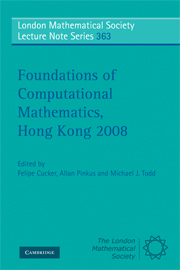Book contents
- Frontmatter
- Contents
- Preface
- Contributors
- 1 Smoothed Analysis of Condition Numbers
- 2 A World of Binomials
- 3 Linear and Nonlinear Subdivision Schemes in Geometric Modeling
- 4 Energy Preserving and Energy Stable Schemes for the Shallow Water Equations
- 5 Pathwise Convergence of Numerical Schemes for Random and Stochastic Differential Equations
- 6 Some Properties of the Global Behaviour of Conservative Low-Dimensional Systems
- 7 A Panoramic View of Asymptotics
- 8 Tractability of Multivariate Problems
3 - Linear and Nonlinear Subdivision Schemes in Geometric Modeling
Published online by Cambridge University Press: 07 September 2011
- Frontmatter
- Contents
- Preface
- Contributors
- 1 Smoothed Analysis of Condition Numbers
- 2 A World of Binomials
- 3 Linear and Nonlinear Subdivision Schemes in Geometric Modeling
- 4 Energy Preserving and Energy Stable Schemes for the Shallow Water Equations
- 5 Pathwise Convergence of Numerical Schemes for Random and Stochastic Differential Equations
- 6 Some Properties of the Global Behaviour of Conservative Low-Dimensional Systems
- 7 A Panoramic View of Asymptotics
- 8 Tractability of Multivariate Problems
Summary
Abstract
Subdivision schemes are efficient computational methods for the design, representation and approximation of 2D and 3D curves, and of surfaces of arbitrary topology in 3D. Such schemes generate curves/surfaces from discrete data by repeated refinements. While these methods are simple to implement, their analysis is rather complicated.
The first part of the paper presents the “classical” case of linear, stationary subdivision schemes refining control points. It reviews univariate schemes generating curves and their analysis. Several well-known schemes are discussed.
The second part of the paper presents three types of nonlinear subdivision schemes, which depend on the geometry of the data, and which are extensions of univariate linear schemes. The first two types are schemes refining control points and generating curves. The last is a scheme refining curves in a geometry-dependent way, and generating surfaces.
Introduction
Subdivision schemes are efficient computational tools for the generation of functions/curves/surfaces from discrete data by repeated refinements. They are used in geometric modeling for the design, representation and approximation of curves and of surfaces of arbitrary topology. A linear stationary scheme uses the same linear refinement rules at each location and at each refinement level. The refinement rules depend on a finite number of mask coefficients. Therefore, such schemes are easy to implement, but their analysis is rather complicated.
The first subdivision schemes were devised by G. de Rahm (1956) for the generation of functions with a first derivative everywhere and a second derivative nowhere.
- Type
- Chapter
- Information
- Foundations of Computational Mathematics, Hong Kong 2008 , pp. 68 - 92Publisher: Cambridge University PressPrint publication year: 2009
- 6
- Cited by

